|
||||||
|
Nature, Birds and Wildlife of Tobago |
|
||||||
|
Nature, Birds and Wildlife of Tobago |
|
Tobago has more species of birds (210) than
any other we have visited. There are 17 species of mammals, 23
species of butterfly, five species of marine turtles, 24
species of snake, 16 species of lizard and 14 species of frog.
Being a small Island, nowhere is very difficult to reach. |
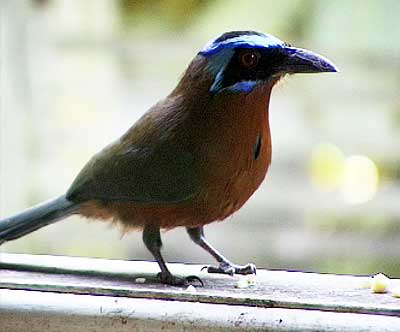 |
This is the Mot Mot,
named - as far as I can understand, after the raucous sound it
makes.
More bird-watching information |
|
Tobago's crowning glory is its bird-life. The noisy Cocricos (grey looking large pheasant type birds) wake you at dawn, as do Amazon green parrots that call to each other from the treetops. At dusk, Mot Mots emerge from the forest and Jacamars leave their hillside burrows. Hummingbirds are everywhere, little jewels hovering above the hibiscus, and there is at least one rare species, the white-tailed sabre-wing, which is pictures below. Other forest birds include the collared trogon and the blue-backed manikin; nightjars and striped owls emerge after dark. We visited the wetlands to film heron and wildfowl species. Several areas in Tobago have been designated as protected reserves or sanctuaries. The rainforest of the Main Ridge is the oldest forest reserve in the western hemisphere. |
|
Little Tobago lies north east of Tobago and due east of the
village of Speyside. Located
approximately 2.8 km from the mainland it is separated by a passage which is
about 4 km long. A strong current runs almost constantly through
this passage (see below) |
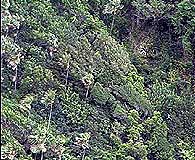 |
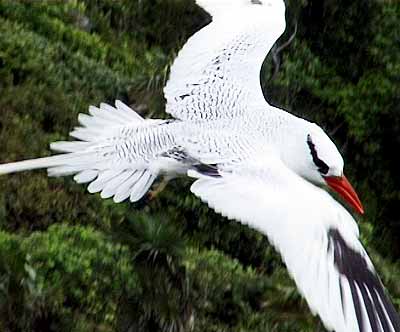 |
This is an important nesting ground for quite a number of seabird species: Audubon's shearwater, the red-footed booby, the sooty tern, the red-billed tropic-bird (a wonderful sight as they dive off the cliffs, their long tails streaming behind them), and more than 30 other species. Little Tobago is one of the prime seabird sanctuaries in the Caribbean. St Giles' Islands, lying off the northernmost tip of Tobago, is another, but access to these rugged little outcrops is difficult and, depending on sea conditions, dangerous. |
|
The Red Billed
Tropic Birds nest in large colonies along the cliffs on Little Tobago. Perched on
top of a cliff we were able to
film these delightful creatures riding the air
currents just feet away. |
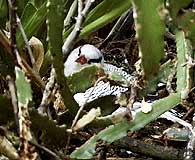 |
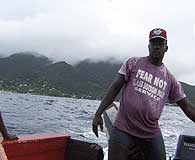 |
We made the voyage in a boat called "Fear Not", an appropriate name as the crossing was one of the worst I had ever encountered (the worst was a trip in a sixteen foot speed boat from Petite Martinique to the neighbouring Grenadines with Carol, where I was convinced we were going to perish, as the horizon repeatedly kept disappearing as we sank into large troughs-see Malcolm's Grenada In both cases, however, the crew were obviously not in the same camp as me, being natural Island sailors, and in both cases the end result was so worth while. If you do not fancy the boat ride, you can watch the birds through binoculars from the excellent vantage point of Flagstaff Hill. |
|
Tobago is also blessed with an abundance of plant, insect and reptile life. If you're interested in discovering the Island's amazing ecology, contact one of the tour operators who organise guided tours into the rainforest. Most hotels will assist in setting these up, or make your own route and explore on your own. This small offshore island is one of the most important sea-bird sanctuaries in the Caribbean, and serves as a haven for a number of species including the Red billed tropic birds, Mot-mot, Hummingbirds, Feral Fowls, Gulls, Yellow Tails, Bare-eye Thrush, Wrens Pigeons Boobies and Sooties. Also found in large populations are Termites, spiders, scorpions, centipedes, earthworms, bats, snails, hermit crabs, snakes, bachac, and lizards. The Bloody Bay Rainforest: The best-signed and most easily identified trail is Gilpin Trace. Rain Forest History: The Main Ridge Forest Reserve is the oldest of its kind in the Western Hemisphere. It was proclaimed a Forest Reserve in perpetuity by an Act of Parliament of April 8th, 1776, shortly after the island fell under British rule. Most of this forest remains natural as it is relatively inaccessible to exploitation, mostly because of its steep and dissected terrain. In addition, the unstable geology curtailed other land use activities and so we continue to have a permanent natural vegetative cover. Hurricanes in 1790, 1847, 1963 and 1974 damaged much of the forested area resulting in a relatively young, present day forest. |
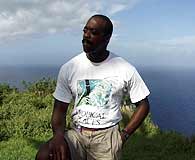 |
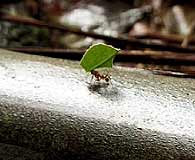 |
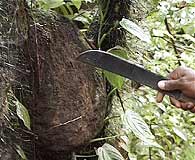 |
|
We booked a rain forest tour with Harrison MacDonald, who has an intimate knowledge of the flora and fauna of Tobago and takes great delight in sharing his survival skills and knowledge of the area. |
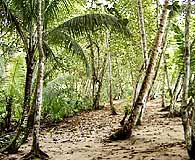 |
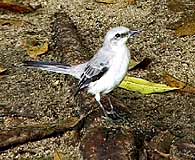 |
 |
|
We combined the rainforest with a tour around some of the beaches. The grey bird is locally given the name Pee Whittler, and the small bird with the red cap is a Manikin ( Let me know if you know different) |
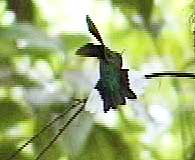 |
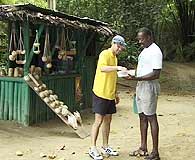 |
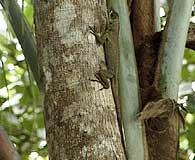 |
|
I was watching the TV the other day and what should be featured but our tour. Harris was looking his usual immaculate self, and the presenter was having a personal tour rather than sharing as we had to, but I was pleased to see that the camera crew had just as much difficulty filming the White tail Sabre Wing Hummingbird as I did. (what you see enlarged in the first picture is a blow up of the bird stretching it's wings and fanning out it's tail looking away from the camera. It looks better on the video) |
|
Location: The main ridge runs from the north east tip south westwards for about two thirds of the length of Tobago and forms the backbone along the island. Its forested mountains rise very steeply from the north coast to a maximum height of about 580 metres and the gentler southern slopes are deeply indented by valleys which run down to a narrow but fertile coastal plain. Though the northern slopes of the Main Ridge are made of some metamorphic rocks the mountains are mostly composed of igneous materials. Climate: The rainfall regime is divided into a dry season and a wet season, the former from January to May and the latter from June to December. There is a slight diminution of rainfall towards October. Precipitation is not annually constant. Rainfall is heaviest on the summits and the Northern slope where in places, it exceeds 360 cm annually. It decreases towards the South, which is a rain shadow area. |
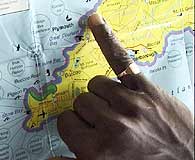 |
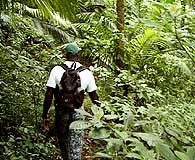 |
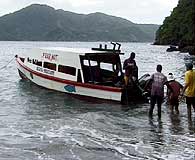 |
|
Importance: The main function of the Main
Ridge Reserve is a protective one. It protects the soil and landscape from
erosion by wind and rain; and river valleys and other agricultural areas from
floods. |
|
Vegetation: The forests on the Main Ridge are all rain forests. That is, they are tall evergreen trees crowded under a
climatic regime where rainfall is seldom scarce but it is well distributed
throughout the year. |
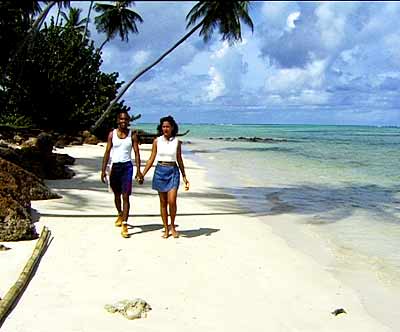 |
|
Cecropia Peltata, Heliconia spp, Miconia spp., Clusea rosea, Simaruba amara, Marila grandiflora, Eschweilera decolorans, Guettards scabra, Ficus tobagenisis, Calopjyllum lucidum, Cordia spp. |
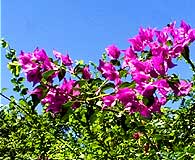 |
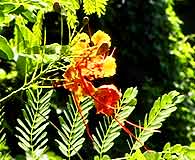 |
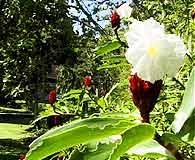 |
|
The Main Ridge gives visitors some of their most
endearing memories. It is a cool, relaxing and pleasant environment
to be in, and offers
many recreational opportunities for hiking, picnicking, bird-watching, sight-seeing,
photography, art and nature study. Every trip to the forest can be educational, inspirational and rewarding. The
Tobago Forest Reserve is maintained and run by the Forestry Section of the Division of Agricultural, Forestry and Marine Affairs, of the
Tobago House of Assembly. |
 |
Grafton Caledonia Wildlife Sanctuary: This
amazing local
bird sanctuary is located near Black Rock village and was once a cocoa estate. After the hurricane in 1963, the
owner took to feeding the wild birds whose
forest habitat was badly damaged. When she died, the estate was passed onto her
remaining family on the condition that it would remain a wildlife sanctuary. |
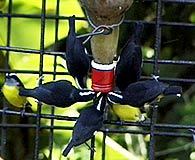 |
 |
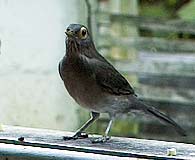 |
|
Feeding time at the Sanctuary. Bananaquits are nectar feeders, while the big grey birds are Cocricos, Tobago's national bird looking like large pheasants. A bare eyed thrush picks up crumbs on a ledge |
|
Accommodation ~ Activities ~ Beaches ~ Calendar ~ Diving ~ Ecology ~ Exploring ~ Fun Facts |
|
This website designed & hosted
by |